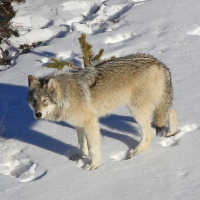 |
Loup de l'île de Baffin |
|
Il est un animal sauvage |
Origine |
Ile de Baffin (Canada) | |
Traduction |
Francis Vandersteen |
| La détention de cet animal n'est pas autorisée Arrêté royal fixant la liste des mammifères non détenus à des fins de production qui peuvent être détenus (M.B. 24.08.2009) |
| Ce n'est qu'en 1943 que le loup de l'île de Baffin a été reconnu comme une sous-espèce distincte par le zoologiste Rudolph Martin Anderson. Son nom trinôme, Canis lupus manningi, a été emprunté au zoologiste Thomas Henry Manning, OC, qui avait cartographié l'île pendant un an et demi. Les loups de l'île de Baffin se trouvent exclusivement sur l'île de Baffin et quelques petites îles adjacentes. Le loup de l'île de Baffin est le plus petit de tous les loups arctiques. Il a un épais manteau blanc qui le fait paraître plus grand qu'il ne l'est en réalité. Les loups de l'île de Baffin sont des créatures omnivores et se nourrissent à peu près de n'importe quoi s'ils ont assez faim. Cependant, leurs principales sources de nourriture sont les lemmings, le caribou des toundras et le lièvre arctique. Ils chassent souvent seul ou un mâle et une femelle ensemble. Le loup de l'île de Baffin figure sur la liste des espèces en voie de disparition. |






 Français (France)
Français (France)